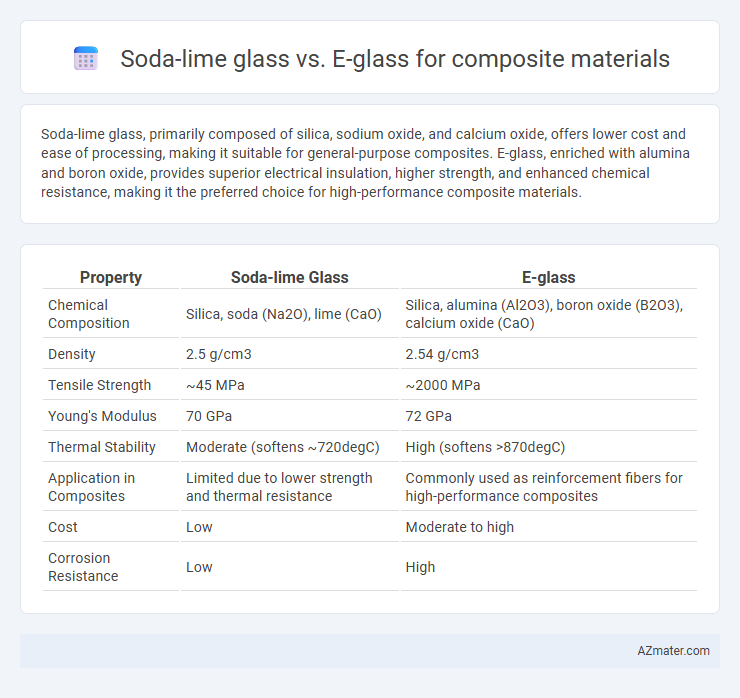Soda-lime glass, primarily composed of silica, sodium oxide, and calcium oxide, offers lower cost and ease of processing, making it suitable for general-purpose composites. E-glass, enriched with alumina and boron oxide, provides superior electrical insulation, higher strength, and enhanced chemical resistance, making it the preferred choice for high-performance composite materials.
Table of Comparison
| Property | Soda-lime Glass | E-glass |
|---|---|---|
| Chemical Composition | Silica, soda (Na2O), lime (CaO) | Silica, alumina (Al2O3), boron oxide (B2O3), calcium oxide (CaO) |
| Density | 2.5 g/cm3 | 2.54 g/cm3 |
| Tensile Strength | ~45 MPa | ~2000 MPa |
| Young's Modulus | 70 GPa | 72 GPa |
| Thermal Stability | Moderate (softens ~720degC) | High (softens >870degC) |
| Application in Composites | Limited due to lower strength and thermal resistance | Commonly used as reinforcement fibers for high-performance composites |
| Cost | Low | Moderate to high |
| Corrosion Resistance | Low | High |
Introduction to Soda-lime Glass and E-glass
Soda-lime glass is the most common form of glass composed primarily of silica, soda, and lime, offering good chemical durability and cost-effectiveness in composite materials. E-glass, or electrical glass, is an alumino-borosilicate glass with enhanced tensile strength, excellent electrical insulating properties, and high resistance to thermal shock, making it ideal for reinforcing composites. The choice between soda-lime glass and E-glass in composites depends on required mechanical performance, thermal stability, and application-specific durability.
Composition and Manufacturing Differences
Soda-lime glass primarily consists of silica (SiO2), sodium oxide (Na2O), and calcium oxide (CaO), and is produced through a batch melting process followed by controlled cooling, making it less expensive but less durable for composites. E-glass, designed specifically for composites, contains higher silica content, alumina (Al2O3), and boron oxide (B2O3), improving its mechanical strength and electrical insulation properties, with manufacturing involving more precise melting and fiberizing techniques to produce fine glass fibers. The compositional differences impact thermal resistance and tensile strength, with E-glass offering superior performance in composite applications due to its specialized manufacturing methods.
Mechanical Properties Comparison
Soda-lime glass in composites exhibits lower tensile strength and stiffness compared to E-glass, with tensile strength typically around 50-90 MPa versus E-glass's 200-400 MPa. E-glass fibers offer superior mechanical properties such as higher Young's modulus (70-85 GPa) and enhanced impact resistance, making them preferred for high-performance composite applications. The improved fiber-matrix adhesion and durability of E-glass contribute to composites with better fatigue resistance and dimensional stability under mechanical loads.
Chemical Resistance and Durability
E-glass composites exhibit superior chemical resistance compared to soda-lime glass due to their enhanced alkali and acid tolerance, making them more suitable for harsh environments. Soda-lime glass, while economical and widely used, tends to degrade faster under prolonged exposure to chemicals, limiting its durability in composite applications. The inherent durability of E-glass in resisting moisture and chemical attacks prolongs the lifespan of composites, especially in marine and industrial settings.
Thermal Stability and Performance
Soda-lime glass exhibits lower thermal stability with a softening point around 570degC, making it less suitable for high-temperature composite applications compared to E-glass, which has a higher softening point near 850degC. E-glass fibers provide superior thermal performance and maintain their mechanical properties at elevated temperatures, enhancing composite durability and resistance to thermal degradation. The enhanced thermal stability of E-glass composites makes them ideal for aerospace, automotive, and industrial applications requiring high temperature resistance.
Cost Analysis: Soda-lime Glass vs E-glass
Soda-lime glass offers a significantly lower cost compared to E-glass, making it a budget-friendly option for composite materials in large-scale applications. E-glass, despite its higher price, provides superior mechanical properties and chemical resistance, which can justify the investment in performance-critical composites. Cost analysis of composites must weigh initial material expenses against long-term durability and application-specific requirements to determine the most economical choice.
Applications in Composite Materials
Soda-lime glass is commonly used as a cost-effective reinforcement in fiberglass composites for automotive and construction applications due to its moderate mechanical properties and abundant availability. E-glass, or electrical grade glass, offers superior strength, chemical resistance, and electrical insulation, making it the preferred choice for high-performance composite materials in aerospace, marine, and sporting goods industries. The enhanced fiber-matrix bonding and durability of E-glass result in composites with higher tensile strength and fatigue resistance compared to soda-lime glass composites.
Advantages and Limitations in Composite Use
Soda-lime glass offers cost-effectiveness and high availability for composite materials but exhibits lower mechanical strength and chemical resistance compared to E-glass. E-glass fibers provide superior tensile strength, durability, and electrical insulation, making them ideal for high-performance composites in aerospace and automotive industries. However, E-glass is more expensive and slightly less environmentally friendly due to its energy-intensive manufacturing process.
Environmental Impact and Sustainability
Soda-lime glass and E-glass differ significantly in environmental impact and sustainability, with soda-lime glass generally offering better recyclability and a lower carbon footprint due to its simpler composition and widespread recycling infrastructure. E-glass, commonly used in composite materials for its superior mechanical properties, requires more energy-intensive production processes and involves higher emissions, although advances in manufacturing aim to reduce its environmental burden. The choice between soda-lime and E-glass for composites balances the trade-off between performance requirements and sustainability goals, with growing emphasis on developing eco-friendly glass fibers and recycling methods to mitigate ecological impact.
Choosing the Right Glass Fiber for Composites
Soda-lime glass fibers offer cost-effective reinforcement with moderate strength and chemical resistance, making them suitable for general-purpose composite applications. E-glass fibers provide superior tensile strength, electrical insulation, and chemical durability, ideal for high-performance composites in aerospace and automotive industries. Selecting the right glass fiber depends on the composite's mechanical requirements, environmental exposure, and budget constraints to ensure optimal performance and longevity.

Infographic: Soda-lime glass vs E-glass for Composite material
 azmater.com
azmater.com